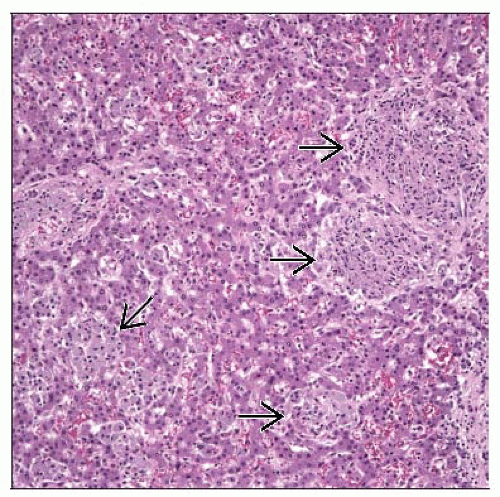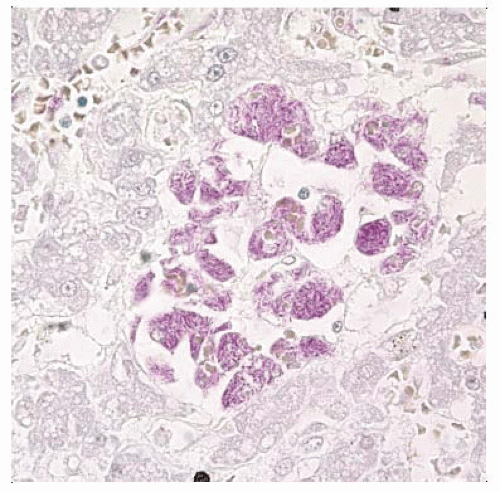Atypical Mycobacteria
Joseph Misdraji, MD
Key Facts
Terminology
Infection by mycobacteria other than tuberculosis or leprosy
Etiology/Pathogenesis
Exposure is almost inevitable due to ubiquitous presence of atypical mycobacteria as environmental saprophytes
M. avium and M. intracellulare, known together as M. avium-intracellulare complex (MAC), are most common atypical mycobacteria to cause hepatic disease
Clinical Issues
Common opportunistic infection in AIDS patients, particularly those that have CD4 counts less than 50 cells/µL
Presents with fever, hepatomegaly, and elevated alkaline phosphatase
Median survival is 6 months
Microscopic Pathology
Poorly formed granulomas, loose aggregates of histiocytes or of foamy histiocytes with numerous acid-fast organisms on acid-fast bacterial stain
Areas of necrosis with nuclear debris surrounded by loose collections of histiocytes and liver abscesses
Fibrin ring granulomas are rare
Ancillary Tests
Histochemical stain for acid-fast bacteria
PCR can be performed on paraffin-embedded tissue
Blood mycobacterial culture
TERMINOLOGY
Abbreviations
Mycobacterium avium-intracellulare complex (MAC)
Definitions
Infection by any one of many species of mycobacteria that does not cause tuberculosis or leprosy
ETIOLOGY/PATHOGENESIS
Infectious Agents
Atypical mycobacteria are potentially pathogenic environmental mycobacteria (a.k.a. mycobacteria other than tuberculosis)
Includes M. avium, M. intracellulare, M. kansasii, M. marinum, M. gordonae, M. chelonae, M. scrofulaceum, M. szulgai, M. malmoense, M. xenopi, M. abscessus, and M. fortuitum
Classified according to growth rate, presence or absence, and type of pigment
M. avium and M. intracellulare, known together as M. avium-intracellulare complex (MAC), are nonchromogens and the most common of atypical mycobacteria to cause hepatic disease
Next to MAC, M. kansasii is most common cause of nontuberculous mycobacterial infection in HIV patients
CLINICAL ISSUES
Epidemiology
Incidence
Up to 35% of all AIDS patients develop disseminated MAC eventually
1-year incidence is 3% among patients with CD4 counts between 100 and 199 cells/µL and 39% for patients with CD4 counts less than 10 cells/µL
Frequency is decreasing with widespread use of highly active antiretroviral therapy (HAART)
Worldwide distribution
Gender
More common in males, mirroring HIV prevalence
Site
Most commonly causes pulmonary disease, lymphadenitis, skin and soft tissue infection
Presentation
Fever
Hepatomegaly
Elevated alkaline phosphatase
Patients treated with HAART may develop clinical manifestations of disseminated MAC due to immune reconstitution inflammatory syndrome (IRIS)
Laboratory Tests
Mycobacterial blood culture establishes diagnosis in 86-98% of patients with MAC confirmed at autopsy
Stay updated, free articles. Join our Telegram channel

Full access? Get Clinical Tree





